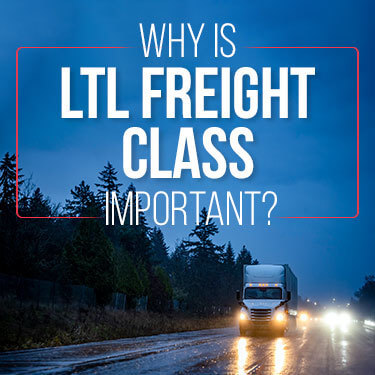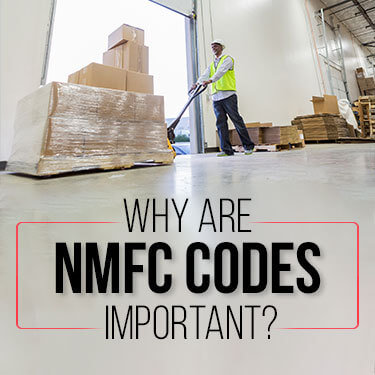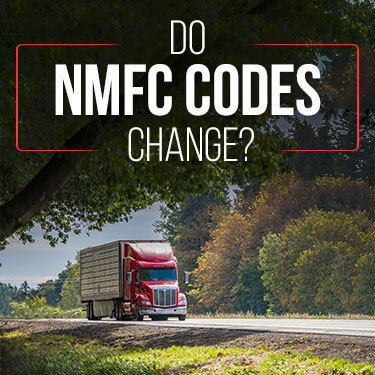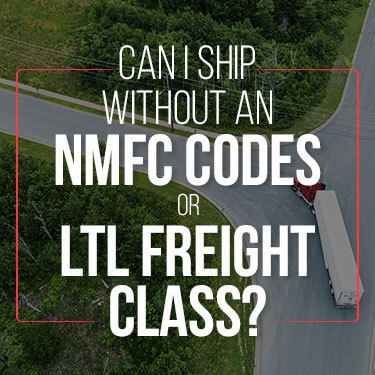LTL Freight Class vs NMFC Codes. These are just two terms that get tossed around in talking about shipping. When you’re someone trying to keep a business moving, clarity is key. See what the difference is between LTL freight class and NMFC codes and how carriers apply them.
The National Motor Freight Traffic Association (NMFTA) developed the LTL freight class ranking chart and National Motor Freight Classification (NMFC) codes. Carriers use both to have national standardized pricing for commodities commonly shipped throughout the United States. New items are ranked and given codes when needed.
Know the impact that LTL freight class can have on shipping rates and how NMFC codes provide adjustments.
LTL freight class and NMFC codes come from the NMFTA and both are important to LTL shipping costs, but they are not the same tool. In basic terms, freight class and NMFC are two different sides to the same coin.
There are 18 LTL freight classes and each of the 18 classes contains a range of different commodities, but no item gets a definitive classification. A freight class may change depending on how an item is packed or its ability to be stacked within a trailer.
Individual commodities are assigned specific NMFC codes. The assigned numbers are five to six digits. Related commodities may begin with the same three digits. For example, codes starting with 183 tend to indicate a type of tobacco or tobacco product.
LTL carriers need both figures for accurate freight shipping calculations. Freight class can be estimated with a freight density calculator, but the NMFC code is going to be the official number used to determine the tariff rate a shipper is going to pay for a particular item to ship.

While carriers offer LTL services, they carry a variety of shipments for different customers. For the customers, this is great because no one shipper ends up burdened with the full cost of transportation services. The money needed to pay drivers, get fuel, and maintain the truck can be divided among the people shipping in that truck.
Since not everyone will have the same amount of cargo to transport, fair payment isn’t the same as an equal payment. LTL freight class provides a standard measurement for calculating costs based on density and dimensions. Standard freight classes allow for fair pricing for LTL shipments so no one pays for space they aren’t using.
In part, this is what makes LTL shipments a more affordable option for many businesses and individuals who only need to ship in small quantities.
To ensure items are classified in a way that is accurate and fair, the NMFTA maintains a three-to-five member council experienced in freight classification. Known as the Freight Classification Development Council (FCDC), they review all freight classifications.
There are four factors the NMFTA uses when assigning commodities to a freight class:
Density is the greatest determining factor when placing a commodity into a specific freight class. LTL carriers want to optimize space in their trailers because the more products they can load, the greater profit they are likely to make.
The 18 freight classes begin with class 50. This class is used to indicate shipments with the highest densities; anything greater than 50 pounds per cubic foot (lbs/ft³). Higher classes will have lower densities. Class 500 is the highest ranking for items that are less than 1lbs/ft³.
The highest density items, like steel rods or bolts, will pay less than lower density items. This is because lower-density items tend to take up more space. Household appliances like washers may be heavy but are mostly empty space.
A shipment of deck screws may weigh 2,500 lbs but can fit on a standard pallet that takes up less than 14 sq. feet of space. The average washing machine weighs about 170 lbs and takes up to six and a half square feet. You would need to ship 14 to 15 washing machines to reach the same weight as a pallet of deck screws and it would take up more room.
Density and Freight Class Comparison
| Items Shipped | Average Density | LTL Freight Class |
| 1 - Pallet of Deck Screws | 37.50 lbs/ft³ | Class 55 |
| 7 - Pallets of Washing Machines (2 per) | 4.25 lbs/ft³ | Class 200 |
The lower density gives the pallets of washing machines a higher freight class despite weighing the same.
Basic freight class calculators found online can give you basic estimates of freight class like the one above. The official freight class will still be determined by the FCDC after analyzing the other factors.
For more information on calculating LTL freight class check out our article, “LTL Freight Classes: Don’t Be Dense About the Impact on Cost”.

NMFC codes are more specific than LTL freight classes because they are assigned to specific commodities. It’s the NMFC number that provides the official LTL freight class for an item.
In the end, NMFC codes are important for the same reason freight classes are: to be able to estimate how much a shipment may cost you.
Once the average density of a commodity is known, the FCFC will use the other metrics to make any necessary adjustments. Stowability, liability, and ease of handling, which were mentioned earlier will be considered.
NMFC codes also indicate to carriers what packages they may need to have more care with. Aside from providing the freight class, they also specify what the proper packaging for that commodity should be.
Packaging rules can be separated into three categories:
Imagine you are shipping glass sheets - heavy and dense commodities but also fragile. They must be carefully packaged and handled to prevent breaks. The correct NMFC code ensures that a standard is set ahead of time while providing your tariff rate.
Despite being of high density, the ease of handling and liability metrics for glass will likely raise its freight class. Knowing this ahead of time can save you from being surprised with your final bill.
Motor carriers that are members of the NMFTA have access to the entire NMFC catalog of codes. To make NMFC codes accessible to shippers, the NMFTA developed an online portal called ClassIT.
Available for a one-time use fee or as a subscription, ClassIt is an online catalog of NMFC codes and all related information for shipping.
With this tool, users can:
The ability to access your products’ NMFC codes before getting quotes from carriers can give you time to package items properly and aim for the highest density class you can.

Yes, NMFC codes can be updated or replaced with new codes. The NMFTA hosts special sessions three times a year for the express purpose of having the FCDC discuss code amendments. All meetings are open to the general public.
Codes may be amended for several reasons. Throughout the year, the NMFTA conducts research based on their ongoing Density Study of commodities. This happens when carriers voluntarily submit their shipping records and recorded density per delivery.
The most common reason for an update of NMFC codes is the creation of subgroups. Cookware, for example, was found to have variable density measurements spanning several classes.
Cast iron cookware in crates or boxes was assigned to freight class 70. Everything from dutch ovens to waffle irons; if it was cast iron and in a box, it was class 70.
After review by the FCDC, the NMFC code for cast iron cookware was replaced by a new number with a series of subgroups. Each subgroup has a different freight class based on the density measurement when shipped.
Subgroup Example: Cookware or Bakeware*
| Subgroup | Density in pounds per cubic foot | Freight Class |
| 1 | Less than 1 | 400 |
| 2 | 1 - 2 | 300 |
| 3 | 2 - 4 | 250 |
| 4 | 4 - 6 | 175 |
| 5 | 6 - 8 | 125 |
| 6 | 8 - 10 | 100 |
| 7 | 10 - 12 | 92.5 |
| 8 | 12 - 15 | 85 |
| 9 | 15 - 22.5 | 70 |
| 10 | 22.5 - 30 | 65 |
| 11 | More than 30 | 60 |
Multiple subgroups now take into consideration a variety of metal cookware and the different quantities it can be shipped in. Instead of having separate NMFC codes for cast iron, aluminum, and sheet steel, they are all categorized as metal bakeware.
Shippers who want to keep track of potential NMFC changes can also do so. The NMFTA website maintains a list of commodities and their NMFC numbers currently under review. Active research projects show the date on which they became active and a contact person for anyone who wants to inquire further.

A shipper that leaves an NMFC code off their Bill of Lading (BoL) risks having their packages reclassed by the carrier. This may result in:
In the above situation, the LTL freight class is still being used, even if a shipper leaves it off the BoL. NMFC codes and LTL freight classes are used to standardize certain aspects of the LTL shipping industry. Choosing to ship without an NMFC code or freight classification doesn’t mean your carrier won’t assign one anyways.
Membership in the NMFTA is voluntary, meaning a carrier does not have to become a member. However, because the majority of the LTL industry does use NMFC codes and freight class, carriers who aren’t members are at a distinct disadvantage.
If you are using a carrier that doesn’t use NMFC codes and freight class, there is no way to estimate your shipping costs ahead of time or be sure that you are getting the best possible rates for your shipment. This may impact the ability to protect your supply chain from price gouging tactics.
Standard LTL freight classes and NMFC codes play a significant role in the North American shipping industry. In a comparison of freight class vs NMFC code, we know how to use both to your advantage. USA Truckload Shipping provides clients with reliable pricing tools and excellent customer service.
Ship with USA Truckload Shipping and know you are partnering with a leader in the LTL freight industry committed to providing the best services for all your transportation and shipping needs.
Aside from LTL services, we also offer:
Allow USA Truckload Shipping to be your partner in transport. Get a service quote and leave your business and shipping needs in the hands of experts.
R+L Global Logistics
315 NE 14th St., Ocala, FL 34470